Lidar-based Studies of Aerosol Optical Properties Over Coastal Areas
Abstract
:1. Introduction
2. Description of experiments and instrumentation
3. Methodology of lidar measurements
- Q = 1.4·10-12 m2 for λ=400 nm
- Q = 3.36·10-12 m2 for λ=700 nm
- Q = 2.2·10-14 m2 for λ=400 nm
- Q = 3.87·10-15 m2 for λ=700 nm
- Q = 2·10-18 m2 for λ=400 nm
- Q = 2.3·10-19 m2 for λ=700 nm
4. Results and discussion
5. Comparison of aerosol retrieval from space with the ground-truth results
6. Conclusions
Acknowledgments
References and Notes
- Vignati, E.; deLeeuw, G.; Berkowicz, R. Modeling coastal aerosol transport and effects of surf-produced aerosols on processes in the marine atmospheric boundary layer. J. Geophys. Res. 2001, 106(D17), 20225–20238. [Google Scholar]
- Dubovik, O.; Holben, B.; Eck, T.F.; Smirnov, A.; Kaufman, Y.J.; King, M.D.; Tanre, D.; Slutsker, I. Variability of absorption and optical properties of key aerosol types observed in worldwide locations. J. Atmos. Sci. 2002, 59(3), 590–608. [Google Scholar]
- Zhuang, G.S.; Huang, R.H.; Wang, M.X.; Zhou, Q.; Guo, J.H.; Yuan, H.; Rao, Z. M. Great progress in study on aerosol and its impact on the global environment. Progress in Natural Science 2002, 12(6), 407–413. [Google Scholar]
- Monahan, E.C.; Mac Niocall, G. Oceanic whitecaps and their role in air-sea exchange processes; D. Reidel Publ. Comp.: Dortrecht, Holland, 1986; p. 129. [Google Scholar]
- Resch, F.J.; Darozzes, S.J.; Afeti, G. M. Marine liquid aerosol production from bursting of air bubbles. J. Geophys. Res. 1986, 91, 1019–1029. [Google Scholar]
- Blanchard, D.C.; Syzdek, L.D. Film drop production as a function of bubble size. J. Geophys. Res. 1988, 93, 3649–3654. [Google Scholar]
- Wu, J. Bubbles in the near-surface ocean. A general description. J. Geophys. Res. 1988, 93, 587–590. [Google Scholar]
- Wu, J. Comment on film drop production as a function of bubble size by D. C. Blanchard and Syzdek. J. Geophys. Res. 1990, 95, 7389–7391. [Google Scholar]
- Fairall, C.W.; Davidson, K.L.; Schacher, G.E. An analysis of the surface production of sea-salt aerosols. Tellus. 1983, 33B, 31–39. [Google Scholar]
- Fitzgerald, W.J. Marine aerosols: A review. Atmos. Environ. 1991, 25A(3/4), 533–545. [Google Scholar]
- Gong, S.L.; Barrie, L.A.; Blanchet, J.P. Modelling sea-salt aerosols in the atmosphere. J. of Geophys. Res. 1997, 102(D3), 3805–3818. [Google Scholar]
- Zielinski, T. Physical properties of aerosol near-water layer in coastal areas. Rozprawy i Monografie IOPAN 2006, 18, 164, in Polish. [Google Scholar]
- Mietus, M.; Owczarek, M. Meteorological conditions. In Environmental conditions in the Polish area of the Baltic Sea in 1997; Cyberska, B., Lauer, Z., Trzosinska, A., Eds.; Materiały Oddziału Morskiego IMGW, 1998; Gdynia; pp. 9–31, in Polish. [Google Scholar]
- Mietus, M.; Filipiak, J.; Owczarek, M. Meteorological condition. In Environmental conditions in the Polish area of the Baltic Sea in 2000; Krzyminski, W., Lysiak-Pastuszak, E., Mietus, M., Eds.; Materiały Oddziału Morskiego IMGW, 2001; Gdynia; pp. 9–32, in Polish. [Google Scholar]
- Zielinski, T.; Zielinski, A.; Piskozub, J.; Drozdowska, V.; Irczuk, M. Aerosol optical thickness over the coastal area of the southern Baltic Sea. Optica Applicata. 1999, 29(4), 339–447. [Google Scholar]
- Zielinski, T.; Zielinski, A. Aerosol extinction and optical thickness in the atmosphere over the Baltic Sea determined with lidar. J. Aerosol Science. 2002, 33(6), 47–61. [Google Scholar]
- Zielinski, T. Changes in aerosol concentration with altitude in the marine boundary layer in coastal areas of the southern Baltic Sea. Bull. PAS. Earth Sci. 1998, 46(3-4), 133–139. [Google Scholar]
- Potter, J. Two-frequency lidar inversion technique. Appl. Opt. 1987, 26(7), 1250–1256. [Google Scholar]
- International Association for Meteorology and Atmospheric Physics, Radiation Commission. A preliminary cloudless standard atmosphere for radiation computation; Boulder, USA, 1984; pp. 9–10. [Google Scholar]
- Hoppel, W.A.; Frick, G.M.; Larson, R.E.; Mack, E.J. Aerosol size distributions and optical properties found in the marine boundary layer over the Atlantic Ocean. Journal of Geophys. Res. 1990, 95, 3659–3686. [Google Scholar]
- O'Dowd, C.D. On the spatial extent and evolution of coastal aerosol plumes. Journal of Geophys. Res. 2002, 107(D 19), 8105. [Google Scholar]
- Hegg, D.A.; Livingston, J.; Hobbs, P.V.; Novakov, T.; Russell, P. Chemical apportionment of aerosol column optical depth off the mid-Atlantic coast of the United States. J. Geophys. Res. 1997, 102, 25293–25303. [Google Scholar]
- Quinn, P.K.; Coffman, D.J.; Bates, T. S.; Miller, T.L.; Johnson, J. E.; Voss, K.; Welton, E. J.; Neusüss, C. Dominant aerosol chemical components and their contribution to extinction during the Aerosol 99 cruise across the Atlantic. J. Geophys. Res. 2001, 106, 20783–20809. [Google Scholar]
- Kiser, R.E. The generation and characterization of surf zone aerosols and their impact on naval electro-optical systems. M.Sc Thesis, Nav. Postgrad. Sch. Monterey, CA, 1996. [Google Scholar]
- Leeuw de, G. Sea spray production from waves breaking in the coastal zone. Journal Aerosol Sci. 1999, 30 (Suppl. 1), S63–S64. [Google Scholar]
- Zielinski, T. Studies of aerosol physical properties in coastal areas. Aerosol Science&Technology 2004, 38(5), 513–524. [Google Scholar]
- Stramska, M.; Petelski, T. Observations of oceanic whitecaps in the north polar waters of the Atlantic. J. Geophys. Res. 2003, 108(C3), 3086. [Google Scholar]
- Zielinski, T.; Petelski, T. Studies of aerosol physical properties in the coastal area. Optica Applicata 2006, 36, 629–634. [Google Scholar]
- Zielinski, T.; Zielinski, A. Breaker zone aerosol dynamics in the southern Baltic Sea. Atmospheric Propagation and Remote Sensing. Proceedings of the SPIE; 1994; Volume 2222, pp. 316–327. [Google Scholar]
- Gathman, S.G. Atmospheric electrical space charge near the ocean surface. In Oceanic Whitecaps; Monahan, E.C., Niocall, M., Eds.; D. Reidel: Norwell, MA, 1983; pp. 227–243. [Google Scholar]
- d'Almeida, G.; Koepke, P.; Shettle, E. Atmospheric aerosols. Global Climatology and Radiative Characteristics; A. DEEPAK Publishing, 1991; p. 561. [Google Scholar]
- Gathman, S.G.; Jensen, D.R. Aerosol characteristics in a coastal region (results from MAPTIP). Proc. SPIE Int. Soc. Opt. Eng. 1995, 2471, 2–12. [Google Scholar]
- Gathman, S.; Smith, M. On the nature of surf generated aerosol and their effect on electro-optical systems. Proc. SPIE Int. Soc. Opt. Eng. 1997, 3125, 2–13. [Google Scholar]
- Hess, M.; Koepke, P.; Schult, I. Optical Properties of Aerosols and Clouds: The Software Package OPAC. Bull. of the American Meteorological Society. 1998, 79(5), 831–844. [Google Scholar]
- Jensen, D.; Gathman, S.; Zeisse, C.; deLeeuw, G.; Smith, M.; Fredrikson, P.; Davidson, K. Electrooptical Propagation Assessment in Coastal Environments (EOPACE): summary and accomplishments. Opt. Eng. 2001, 40(8), 1486–1498. [Google Scholar]
- Von Hoyningen-Huene, W.; Weindisch, M. Possibility of refractive index determination of atmospheric aerosol particles by ground-based solar extinction and scattering measurements. Atmos. Environ. 1994, 28, 785–792. [Google Scholar]
- Weller, M.; Leiterer, V. Experimental data on spectral aerosol optical thickness and its global distribution. Beitr. Phys. Atmos. 1988, 61(l), 1–9. [Google Scholar]
- Schifrin, K.S.; Yershov, O.A.; Lysenko, E.L.; Volkov, B.N. Optical studies of aerosol structure over the island of Kihnu, Optical methods of studying the oceans and inland waters. K. S. Shifrin, Ed. Tallinn 1980, 244–248. [Google Scholar]
- Smirnov, A.; Villevalde, Y.; O'Neill, N.T.; Royer, A.; Tarussov, A. Aerosol optical depth over the oceans: analysis in terms of synoptic air mass types. J. Geophys. Res. 1995, 100(D8), 16639–16650. [Google Scholar]
- Kuśmierczyk-Michulec, J.; Schulz, M.; Ruellan, S.; Kruger, O.; Plate, E.; Marks, R.; de Leeuw, G.; Cachier, H. Aerosol composition and related optical properties in the marine boundary layer over the Baltic Sea. Journal Aerosol Sci. 2001, 32(8), 933–955. [Google Scholar]
- Hoppel, W.A.; Frick, G.M.; Larson, R.E.; Mack, E.J. Aerosol size distributions and optical properties found in the marine boundary layer over the Atlantic Ocean. Journal of Geophys. Res. 1990, 95, 3659–3686. [Google Scholar]
- Reddy, P.J.; Kreiner, F.W.; DeLuisis, J.J.; Kim, Y. Aerosol optical depths over the Atlantic derived from shipboard sunphotometer observations during the 1988 Global Change Expedition. Global Biogeochem. Cycles 1990, 4, 225–240. [Google Scholar]
- Pflug, B.; Krawczyk, H.; Posse, P. Atmospheric ground-truth measurements for validation of MOSdata and Angström algorithm. Proceedings of the 3rd Berlin Workshop on Ocean Remote Sensing; 1999; pp. 121–131. [Google Scholar]
- Smirnov, A.; Holben, B.N.; Sakerin, S.M.; Kabanov, D.M.; Slutsker, I.; Chin, M.; Diehl, T.L.; Remer, L.A.; Kahn, R.; Ignatov, A.; Liu, L.; Mishchenko, M.; Eck, T.F.; Kucsera, T.L.; Giles, D.; Kopelevich, O.V. Ship-based aerosol optical depth measurements in the Atlantic Ocean: Comparison with satellite retrievals and GOCART model. Geophysical Research Letters 2006, 33(14), L14817. [Google Scholar]
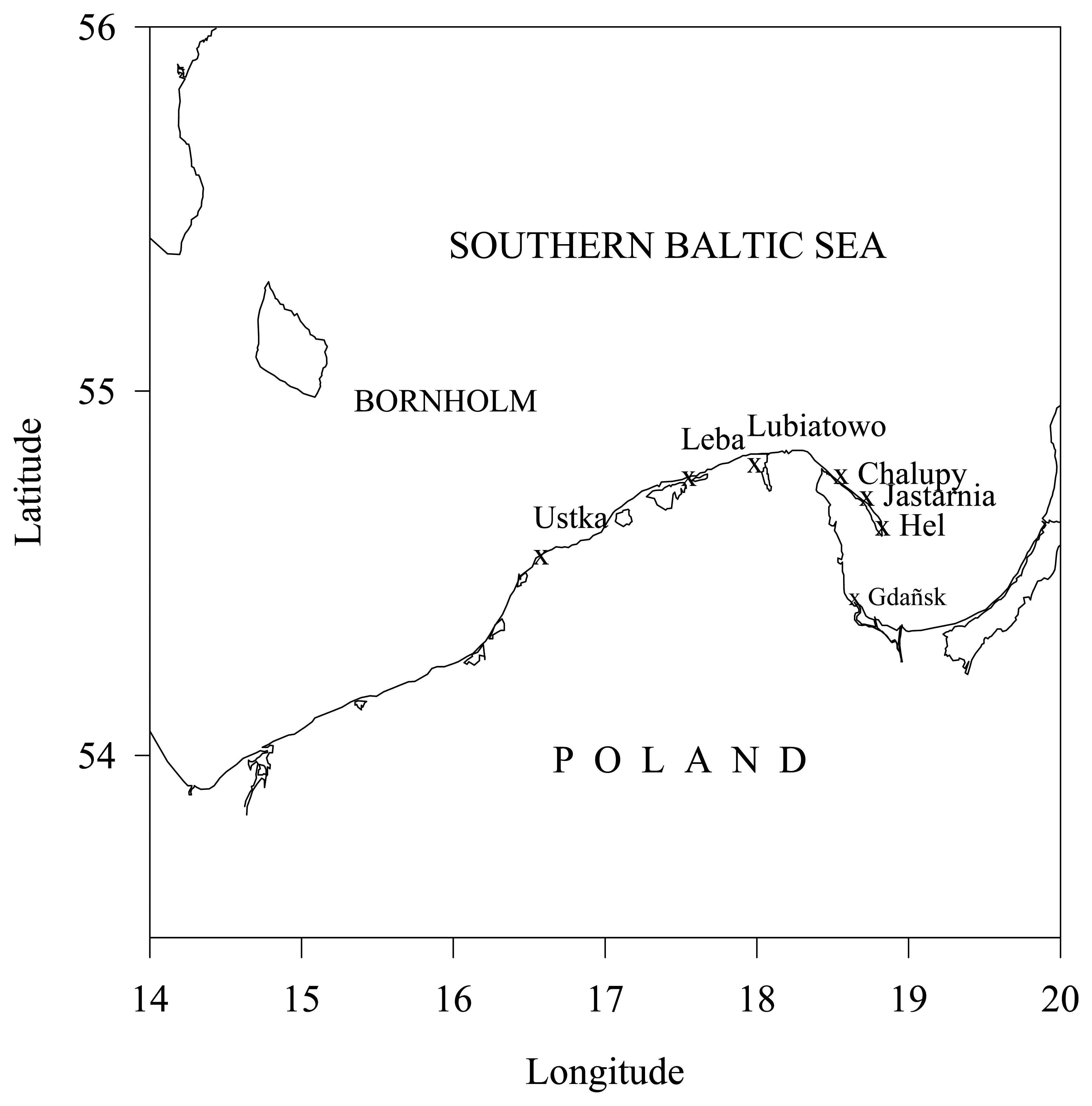
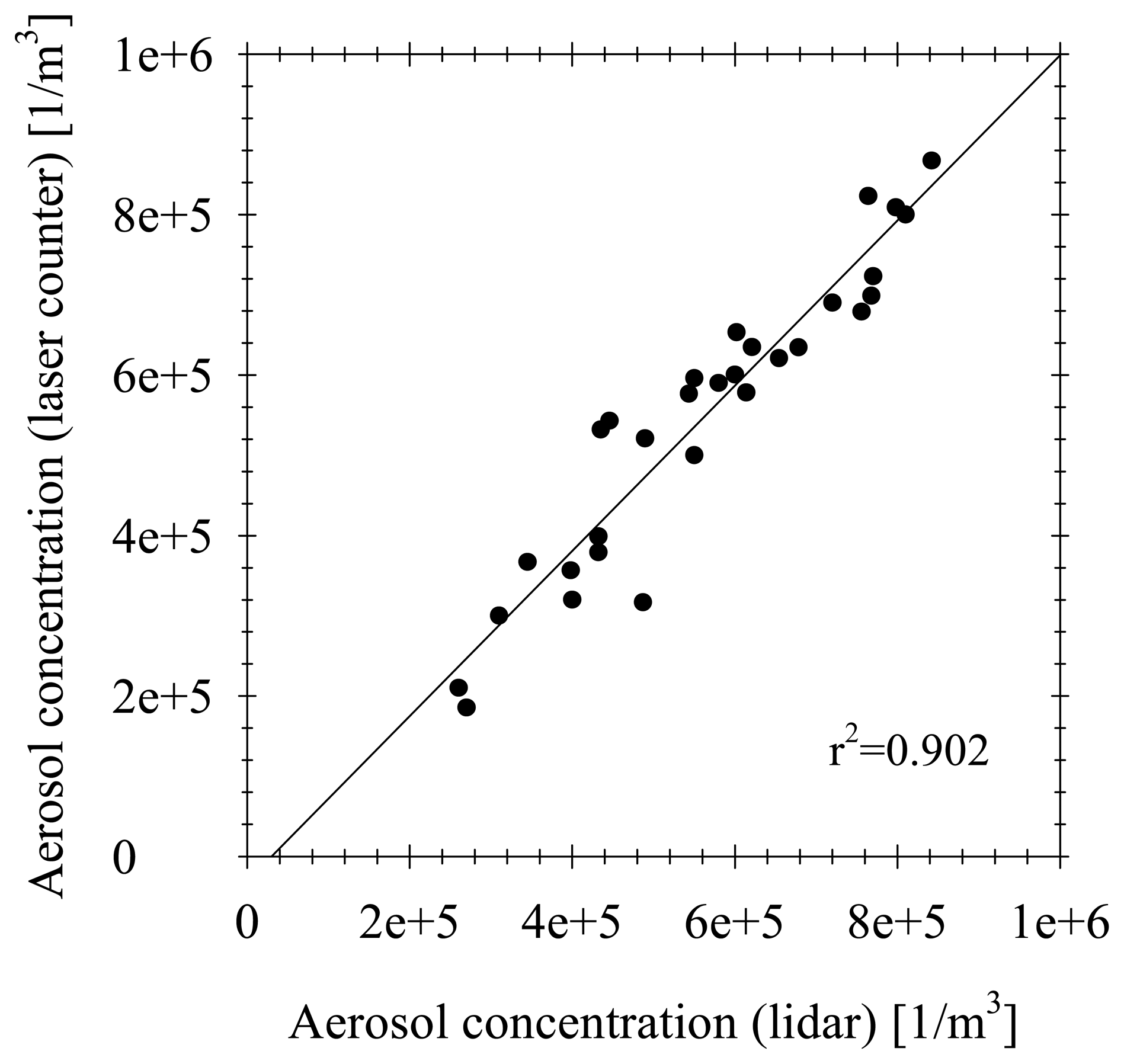
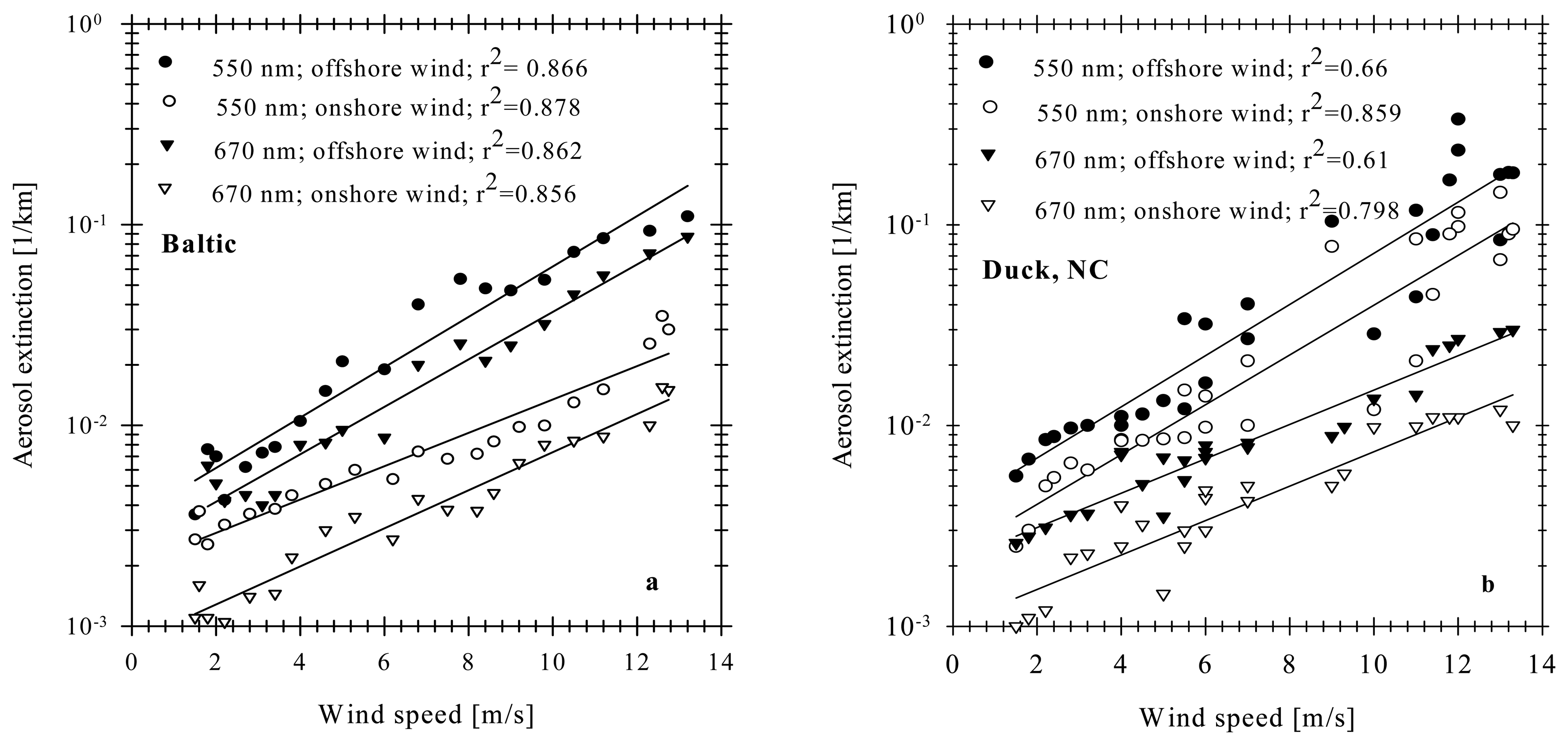
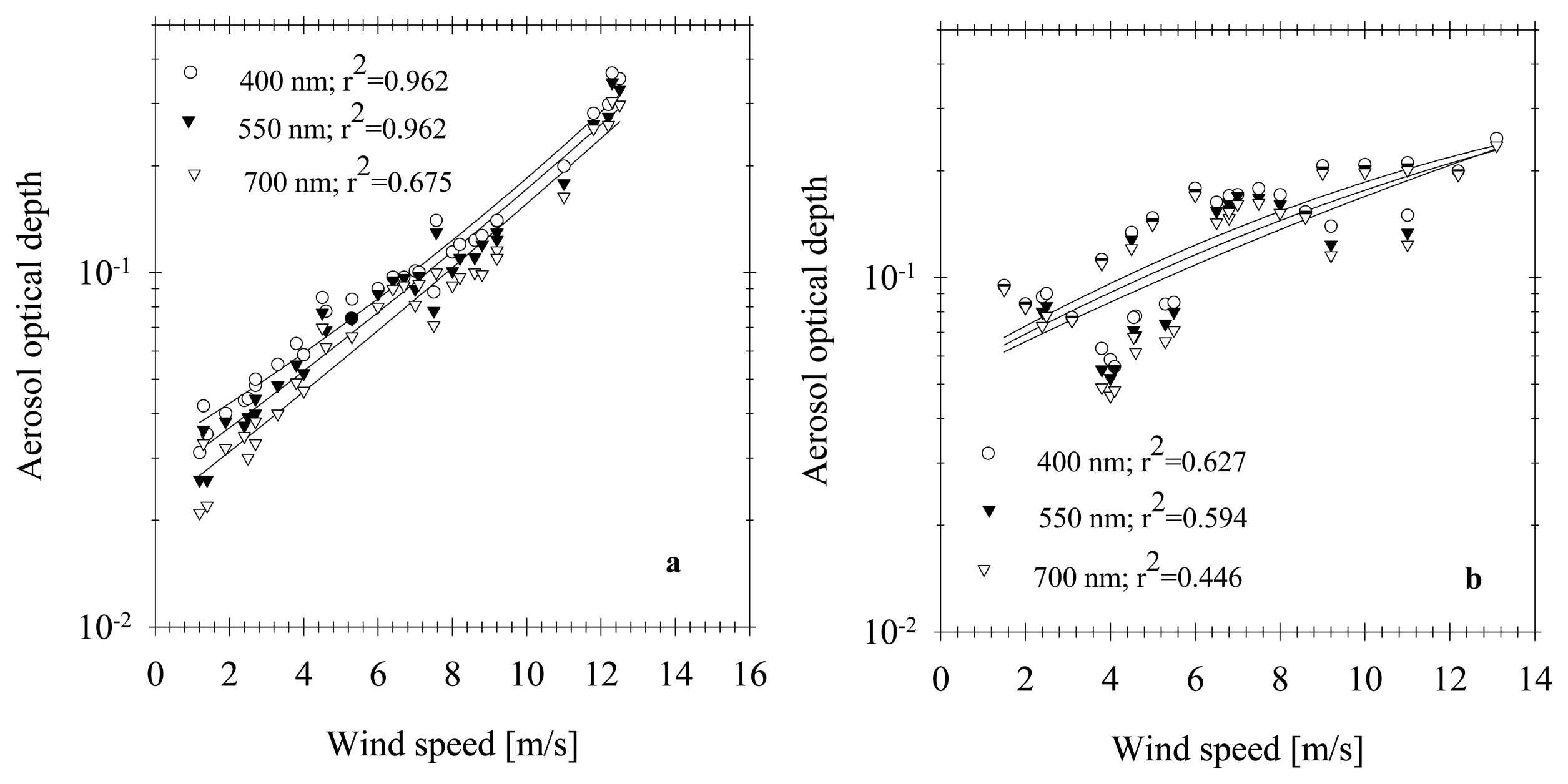
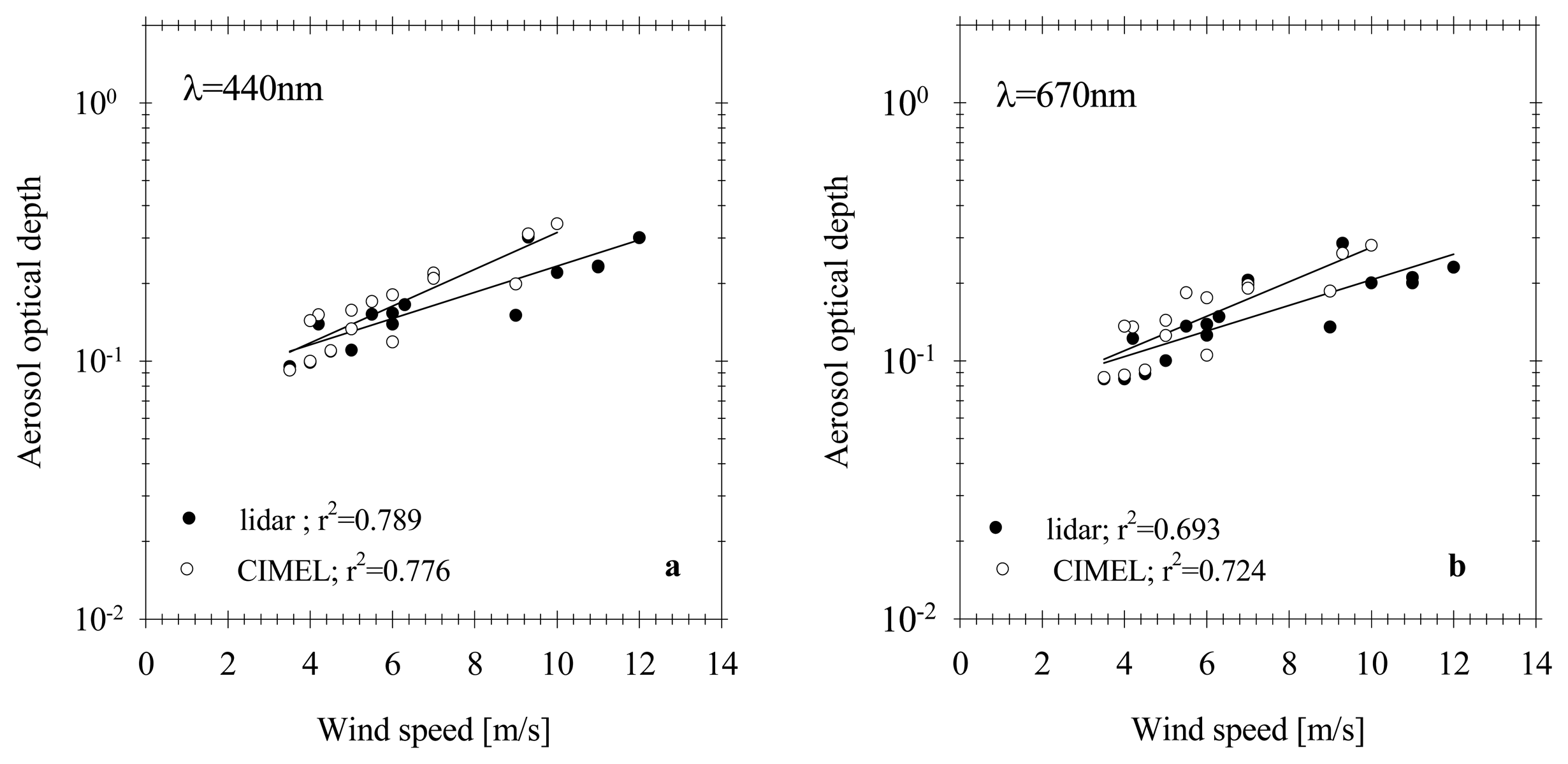
| Measurement periods 1993-2003 | Number of experiments | Prevailing wind directions | Meteorological conditions | |||||||
|---|---|---|---|---|---|---|---|---|---|---|
| T [°C] | RH [%] | p [hPa] | v [m/s] | |||||||
| Min. | Max. | Min. | Max. | Min. | Max. | Min. | Max. | |||
| March | 2 | SE | -2.6 | 5.4 | 66 | 81 | 982 | 1028 | 3.8 | 8.6 |
| April | 2 | N, NE, SW, SE | 2.3 | 9.4 | 67 | 93 | 986 | 1027 | 2.2 | 9.7 |
| May | 3 | N, NE, SW | 7.2 | 18.4 | 65 | 94 | 990 | 1032 | 2.0 | 6.8 |
| September | 2 | NE, SE, SW | 9.3 | 20.3 | 53 | 93 | 988 | 1018 | 4.6 | 11.0 |
| October | 3 | N, NE, SW, W | -2.1 | 8.6 | 62 | 96 | 990 | 1018 | 4.0 | 13.0 |
| November | 1 | SW | -2.5 | 3.2 | 55 | 78 | 1018 | 1024 | 3.1 | 12.0 |
| Total | 13 | |||||||||
| Season 1992-2006 | No. of experiments | No. of days with onshore winds | No. of days with offshore winds |
|---|---|---|---|
| Spring (late March, April, May, June) | 7 | 52 | 40 |
| Fall (September, October, November) | 6 | 22 | 60 |
| Total | 13 | 74 | 100 |
| Day in March 1999 | Meteorological conditions | ||||||||||
|---|---|---|---|---|---|---|---|---|---|---|---|
| Tw[°C] | Tp [°C] | RH [%] | p [hPa] | V [m s-1] | Wind direction | ||||||
| Min. | Max. | Min. | Max. | Min. | Max. | Min. | Max. | Min. | Max. | ||
| 1 | 5.37 | 6.25 | 4.4 | 10.5 | 51 | 72 | 996 | 1003 | 5.2 | 8.6 | Offshore |
| 2 | 4.56 | 6.80 | 7.2 | 14.4 | 52 | 68 | 1003 | 1017 | 4.2 | 7.3 | Offshore |
| 3 | 5.79 | 8.24 | 5.3 | 15.4 | 63 | 97 | 998 | 1016 | 5.8 | 8.7 | Onshore |
| 4 | 5.32 | 7.41 | 4.7 | 7.7 | 48 | 67 | 997 | 1014 | 3.0 | 9.8 | Onshore |
| 5 | 4.39 | 5.12 | 5.1 | 10.6 | 46 | 66 | 1017 | 1030 | 0.6 | 8.5 | Onshore |
| 6 | 7.20 | 8.33 | 5.1 | 17.5 | 65 | 67 | 1017 | 1028 | 3.1 | 9.2 | Onshore |
| 7 | 7.81 | 8.36 | 0.3 | 9.3 | 53 | 73 | 1015 | 1026 | 9.6 | 10.0 | Offshore |
| 8 | 6.98 | 7.45 | 0.7 | 1.6 | 66 | 76 | 1026 | 1036 | 12.1 | 13.7 | Offshore |
| 9 | 4.87 | 6.18 | 2.2 | 5.3 | 58 | 87 | 1011 | 1034 | 4.1 | 6.5 | Offshore |
| 10 | 5.1 | 6.20 | 3.4 | 5.6 | 85 | 96 | 1011 | 1015 | 3.8 | 6.4 | Offshore |
| Excimer laser | |
| Wavelength | 308 nm |
| Pulse energy | 70 mJ |
| Pulse duration | 20 ns |
| Pulse repetition | 1; 10 Hz |
| Tunable dye laser | |
| Wavelength region | 320 to 670 nm |
| Pulse duration | 15 ns |
| Efficiency of pumping energy transforming | >15 % |
| Beam divergence | < 1 mrad |
| Generation line width | < 0.1 nm |
| Receiver | |
| Spectral range | 400 to 750 nm |
| Conversion time | 50 ns |
| ADC converter | 10 bit |
| Telescope | |
| Mirror diameter | 280 mm |
| Focal length | 635 mm |
| Distances of optimal energy focusing, tunable | 10 to 2000 m |
| Polychromator | |
| Spectral region | 425 to 800 nm |
| Diffraction grating | 450 lines/mm |
| Aerosol extinction [1/km] at λ = 550 nm | Aerosol extinction [1/km] at λ = 675 nm | |||
|---|---|---|---|---|
| Onshore wind v=7.5 m/s | Offshore wind v=5 m/s | Onshore wind v=7.5 m/s | Offshore wind v=5 m/s | |
| Lidar h=32 m Duck, NC | 0.0049 | 0.0013 | 0.0032 | 0.00098 |
| Laser counter h=4 m Duck, NC | 0.013 | 0.0098 | - | - |
| Lidar h=30 m Baltic | 0.0068 | 0.0046 | 0.0046 | 0.0028 |
| Lidar h=4 m Baltic | 0.0096 | 0.0073 | 0.0067 | 0.0057 |
| Laser counter h=4 m Baltic | 0.010 | 0.0077 | - | - |
| Author | Type of air mass | Extinction coefficient [1/km] | Study area | Description |
|---|---|---|---|---|
| Gathman, 1983 [31] | Continental | 0.370 | NAM - Navy Aerosol Model | h = 4 m a.s.l. RH = 80% v = 8 m s-1 |
| d'Almeida and Koepke, 1991 [32] | Continental Marine | 0.167 0.078 | Global Aerosol Model | Atmospheric column RH = 80% |
| Gathman and Jensen, 1995 [33] | Continental Marine | 0.58 0.04 | Coastal station Katwijk aan Zee, Holand | h = 2 m a.s.l. |
| Gathman and Smith, 1997 [34] | Marine | 0.32 | San Diego Bay, USA | h = 4 m a.s.l. RH = 80% v = 1.8 m/s |
| Gathman and Smith, 1997 [34] | Marine | 0.103 | San Diego Bay, USA | h = 8 m a.s.l. RH = 80% v = 1.8 m/s |
| Hess et al., 1998 [35] | Continental Urban Marine | 0.151 0.353 0.090 | Model OPAC-Optical Properties of Aerosols and Clouds | Atm. column h∈[0; 2000 m] RH = 80% |
| Jensen et al., 2001 [36] | Marine | 0.6 | Monterey Bay, USA | h = 4 m a.s.l. RH = 80% |
| Jensen et al., 2001 [36] | Marine | 0.1 | Monterey Bay, USA | h = 10 m a.s.l. RH = 80% |
| Zielinski, 2006 [12] | Marine (lidar) | 0.0096 | Baltic | h = 4 m a.s.l. RH = 80% v = 7.5-9 m/s |
| Zielinski, 2006 [12] | Marine (lidar) | 0.0068 | Baltic | h = 30 m a.s.l. RH = 80% v = 7.5-9 m/s |
| Spring Onshore wind speeds, v∈[3.8, 4.8] | |
| AOD range | 0.055-0.071 |
| Fall Offshore wind speeds v∈[4.8, 6.0] | |
| AOD range | 0.144-0.174 |
| Author | Air mass type | AOD at 550 nm | Region |
|---|---|---|---|
| Weller and Leiterer (1988) [38] | Continental | 0.62 | Baltic |
| Marine | 0.18 | Baltic | |
| Von Hoyningen-Huene and Wendisch (1994) [37] | Continental | 0.29 | Baltic |
| Marine | 0.10 | Baltic | |
| Schifrin et al. (1980) [39] | Marine/coastal | 0.20 | Baltic |
| Schifrin et al. (1980) [39] | Marine/coastal | 0.16 | Black Sea |
| Smirnov et al. (1995) [40] | Continental/coastal | 0.33 | Black Sea |
| Kuśmierczyk-Michulec et al. (2001) [41] | Continental/mixed | >0.26 | Baltic |
| Marine | 0.26< | Baltic | |
| Zielinski (2006) [12] | Continental | 0.21 | South. Baltic coastal |
| Marine | 0.09 | South. Baltic coastal | |
| Hoppel et al. (1990) [42] | Continental | 0.13 | Atlantic |
| Marine | 0.08 | Atlantic | |
| Reddy et al. (1990) [43] | Continental | 0.50 | Atlantic |
| Marine | 0.11 | Atlantic | |
| Smirnov et al. (2006) [44] | Marine | 0.06-0.08 | South Atlantic |
| Zielinski (2006) [12] | Continental | 0.21 | Duck, NC |
| Marine | 0.11 | Duck, NC | |
| Zielinski (2006) [12] | Marine | 0.07 | Greenland Sea |
| Zielinski, 2006 | Continental | 0.22 | Crete coast |
| Ground-truth | PCI-Algorithm | |
|---|---|---|
| 22.09.2002 | 0.06 | 0.04 +/-0.002 |
| 23.09.2002 | 0.02 … 0.03 | 0.05 +/-0.004 |
| 27.09.2002 | 0.13 … 0.14 | 0.08 +/-0.005 |
| Ground-truth | Angström-Inversion | |
|---|---|---|
| 22.09.2002 | 1.5 | 1.0 +/- 0.2 |
| 23.09.2002 | 1.2 | 3.1 +/- 0.8 |
| 27.09.2002 | 1.2 … 1.8 | 1.4 +/-0.1 |
© 2007 by MDPI ( http://www.mdpi.org). Reproduction is permitted for noncommercial purposes.
Share and Cite
Zielinski, T.; Pflug, B. Lidar-based Studies of Aerosol Optical Properties Over Coastal Areas. Sensors 2007, 7, 3347-3365. https://doi.org/10.3390/s7123347
Zielinski T, Pflug B. Lidar-based Studies of Aerosol Optical Properties Over Coastal Areas. Sensors. 2007; 7(12):3347-3365. https://doi.org/10.3390/s7123347
Chicago/Turabian StyleZielinski, Tymon, and Bringfried Pflug. 2007. "Lidar-based Studies of Aerosol Optical Properties Over Coastal Areas" Sensors 7, no. 12: 3347-3365. https://doi.org/10.3390/s7123347





